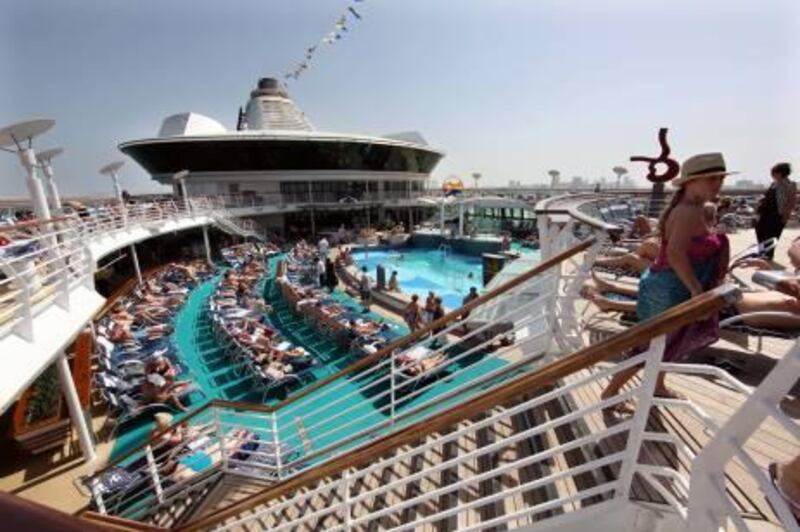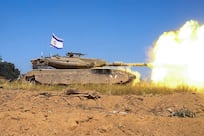Passengers and crew alike on board the Brilliance of the Seas kept calling my wife and I "brave" for picking a 16-day voyage from Dubai to Spain to be our first cruise experience.
They said it wasn't the threat of Somali pirates in the Gulf of Aden or the turmoil in Egypt that should have given us pause, but rather the protracted nine straight days at sea - a Royal Caribbean record.
Some said it was the cruise equivalent to making Mount Everest your first hike. Actually, there is no cruise equivalent to hiking Everest, which is, indeed, part of the appeal of cruising - but that's the kind of hyperbole that begins to make sense after several days on the water.
There was really just one reason we took so long to get our sea legs - cost. We knew cruises had a lot to offer but, when push came to shove, we thought that once you factored in airfare and hotel stays, it would be like getting one holiday for the price of two.
In April, however, a unique set of circumstances flipped this math on its head. First, our schedules suddenly opened up, making a three-week holiday possible.
Second, while browsing vacationstogo.com, I discovered that the Brilliance was ending its seasonal stint in the Emirates and making a one-way "repositioning voyage" back to the Mediterranean. For us, this meant getting on a top-class cruise ship would be as easy as hailing a cab.
Third, Egypt was cancelled as a port of call, meaning no photos next to pyramids. We would still make the 200-kilometre Suez Canal crossing, though, and slow down long enough to wave "hello" to the machine-gun toting soldiers on the waterway's edge, but due to the geopolitical situation we wouldn't be stopping this time to shake their hand.
This triggered a wave of guest cancellations weeks prior to the trip, and prices plummeted. It was a win-win-win, even though we had to listen to our relatives back home - saturated by news of the Arab Spring and pirate attacks - call our trip "Curt and Olga's Suicide Cruise".
But even they couldn't argue with my math. Including taxes and fees and one-way tickets from Barcelona back to Dubai, our entire 16-day voyage was no more expensive than staying in a nice hotel anywhere in the UAE for the same length of time.
"You line up any other holiday plan - where you're going, how long you'll be there, what you can do while on your way there - and this is by far the best deal around," said Rob Koczwara, a 51-year-old investment broker and fellow cruise passenger from Perth, Australia. "Even after you factor in air travel, it still can't be beat."
"It's really three holidays in one," summed up Matt Sole, the ship's jovial British cruise director, during one of the first of his informative daily TV shows that aired in our cabin during the voyage. "First you have the tour of the Middle East: Dubai, Abu Dhabi, Fujairah and Muscat. Then you have nine sea days, a true ocean voyage that ends with a unique trip through the historic Suez Canal. And, finally, you have a full Mediterranean holiday in Rome, Pisa and Barcelona."
We were sold (by then there was no chance for a refund even if we weren't) and ready to go.
We started a day late, opting to let the ship come to us in Abu Dhabi, and we thought we might be the only new passengers walking the gangplank at Mina Zayed Port. But we found there was still a crowd streaming in - a delayed Delta Airlines flight had caused many passengers to miss embarkation in Dubai, and they had to hire taxis to catch up to the Brilliance in Abu Dhabi. Cruise ships stick to a strict schedule, and if you - and even dozens just like you - miss the boat, you miss the boat.
We found our first day on the ship was like the first day at a new school. We got lost a lot, staring at deck maps near the elevators for minutes and not seconds. But it was a lot to take in. While not the biggest floating hotel on the water (a title that belongs to one of its sister ships, the 360-metre Allure of the Seas), the nine-year-old, 293-metre Brilliance of the Seas has 12 decks and can hold more than 2,500 passengers. From rock-climbing walls to pools and Jacuzzis to golf simulators, not to mention a cinema and a two-tier theatre for live performances, it takes a while to learn not only where to go, but what you can do once you get there.
It was only after we found our cabin that we saw the Cruise Compass on our bed, a daily newsletter that lists all the ship activities and helps you plan your day. My wife immediately grabbed our copy from me so she could circle items of interest with a pen.
Seasickness is cruising's chief "known unknown". You would think 90,000 tonnes of ship equipped with modern stabilisers headed in a straight line at 22 knots would be almost always "steady as she goes" - and you would be right. Yet, unfortunately, there are only two ways ships like the Brilliance make news. First, when they are commissioned; and second, anytime something goes wrong. In December, this very ship was battered by waves and 70-knot winds en route to Alexandria, Egypt, injuring dozens of passengers.
But aside from the first day in the Mediterranean when the horizon bobbed for a couple of hours, the entire voyage was less bumpy than any transcontinental flight.
The sea was particularly calm after we left Muscat - almost too calm.
"You take day watch, I'll take night watch," I joked with my wife, after we found a letter in our stateroom preparing us for a safety drill as we approached "Pirate Alley". In the note, the captain, Manolis Kasselas, explained that, while in the Gulf of Aden, the exterior lights would be turned off and the open areas on the top decks would be closed at night.
We also had to take part in a five-minute "safe haven" drill. All passengers in outside cabins were required to move into the middle of the ship once a signal blared from the public address system. Guests were instructed to keep their stateroom lights off near their windows and their curtains closed at night during the four-day passage. We forgot once and received a knock on our door and a polite reminder. While taking a daytime poolside stroll, I did spot a suspicious speed boat near the horizon moments before security personnel ran behind me with binoculars to get a better look. However, it was moving in the opposite direction.
As we entered the Red Sea, we could see the coast of Yemen on the right and the coast of Somalia on the left while eating breakfast in the Windjammer Cafe. An elderly German gentlemen sitting next to me with intermediate English skills still managed to sum up the situation perfectly with the help of some instructive finger-pointing: "Here fine. There problem, there problem".
If not books, then certainly hundreds of forum web pages on sites like cruisecritic.com have been devoted to staterooms - the best cabins on each ship, the quietest decks, the cabins with the best views and, most importantly, how to get a free cabin upgrade. After much investigation, I can report there is no magic formula for the latter, but having a spouse with puppy-dog eyes work the customer service desk on a ship with less than 50 per cent occupancy can help.
We were initially assigned an inside cabin on deck 7, which was just above the casino and near the engine. Researching the forums, I knew this area could be a noise hazard. But the casino was almost always empty on this voyage, and the engine hum served more as white noise, muffling other sounds as we slept. At only a little more than 50 square metres, both the interior and exterior cabins with windows are designed for sleep and not much else. Still, they were surprisingly comfortable and usable for the few hours a day you should be spending in them conscious. The beds were particularly cosy. The bathrooms were cramped, of course, but the water pressure in the tiny shower was better than in my last four apartments. For the last week of the cruise, we managed to get a cabin upgrade, which afforded a few more square metres of space and a private balcony just in time for great views of Sicily and Italy.
After nine days at sea, we were ready to touch ground in Civitavecchia, Italy, even though we managed only 10 steps before boarding a bus for a 90-minute ride to Rome. We opted for the more expensive ship-sponsored "Explorations!" tour of the Colosseum and Vatican City. The crew's warnings about "going solo and missing the boat" were gentle but effective, and we decided we wanted a tour guide whose livelihood depended on getting us back to the Brilliance on time.
Despite jarring yells by Vatican City workers to quiet the murmuring crowd, seeing Michelangelo's version of the story of creation on the ceiling of the Sistine Chapel just days after Pope John Paul II's beatification was particularly moving alongside a few hundred believers, dozens of whom could not hold back their tears.
The ship's next stop was to be Livorno, Italy - a gateway port to Florence and Pisa - but, once again, world events intervened. With a nationwide labour strike only two days away, the working port decided to cancel the Brilliance's reservation at the last minute so cargo ships could be emptied while dock workers were still on the job. This was actually good news, because our ship's Plan-B port was La Spezia, a bit farther north and an infinitely more picturesque and tourist-friendly spot filled with shops, eateries and bars. One was left to wonder, then, why La Spezia wasn't Plan A. The cynic in me suspects that, unlike the homely Livorno, the free sights and sounds around La Spezia are entertaining enough to compete with the ship's pricey excursions. The ship provided several tour options at each port of call, including "panoramic" bus tours that required little, if any, walking for older guests.
Royal Caribbean cruises usually cater towards the family demographic, although crossings are more likely to attract a "seasoned" clientele with enough free time to devote to such a journey. While walking along the Solarium, an enclosed glass globe on deck 11 offering sunshine without the heat, I couldn't help but smirk at several snoozing octogenarians out cold on beach chairs, books draped across their bellies. I'm glad I kept my snide thoughts to myself, however, because two days later I found myself in the exact same state.
"They work very, very hard to please on this ship," said Sue Hamby, a 73-year-old cruise veteran from Waco, Texas, who went on her first cruise to Vietnam on the SS President Wilson in 1967 by entering her sailor husband into a contest sponsored by the US Navy. Mrs Hamby, who's been on almost every cruise line, from Carnival to Hurtigruten - a little-known Norwegian line with a fleet of ferries that double as mail ships - says the efforts of Royal Caribbean's crew makes their voyages stand out. "It's unusual to be on a ship and have a maître d' come to your table and say, 'is everything OK?' Usually you don't see him until the last day, the day of tipping."
Almost everything you consume is included in the price once you book a cruise, unless you want alcohol, soda, freshly squeezed juice or something from Seattle's Best Coffee on deck 6. There are also certain speciality restaurants (in the Brilliance's case, Portofino and Chops Grille) that cost $20 (Dh73) and $25 (Dh92) extra per person, respectively. I paid an extra $99 (Dh363) for the "soda package", which meant I could drink as much Diet Coke as I wanted and no one could stop me (because my wife was too busy taking belly dancing classes).
Most people ate "for free" most of the time at either the Windjammer Cafe buffet on deck 11, or the more traditional Minstrel dining room on decks 4 and 5. The food was excellent, especially when you consider most of it had to start out frozen. And although the Minstrel served in a traditional appetiser-entrée-dessert format (with high-style service that included crumb brushing), my wife and I often shunned decorum and ordered three or more appetisers just because we could. A typical adjective-laden chef's signature menu included chilled cherry bisque, mustard-crusted roast beef and pecan butterscotch tart. The restaurant also offered an 800-calorie or less menu that included dishes such as lentils and root vegetable soup, fillet of Atlantic salmon and low-fat poached peaches.
"Keeping everybody happy with different kinds of food for a journey this long can be a challenge," said Ajay Pradhan, the Brilliance's sous chef. The ship employs 103 cooks and seven chefs who must be ready to serve 11,000 meals a day working from the more than 40,000kgs of food stored on board. Inside the intricate galleys, staff must operate with a level of precision and forethought worthy of a national space programme - they even have a separate fridge for bananas.
Pradhan said they tried to mix things up by offering hot dogs and tacos poolside during the day, but even that proved a challenge in the Gulf of Aden. "The ship had to go at high speeds as a safeguard against pirates, and the wind made it difficult to keep a flame going for the barbecue," he said. Still, Brilliance managed to keep most passengers happy. As a Scottish man quipped while holding his stomach in the elevator en route to the theatre after dinner, "I came on board as a passenger, but I'm leaving as cargo."
Twice a night during sea days, the ship's Pacifica Theatre was the setting for an array of entertainment: Beatles, Rat Pack and Celine Dion singalikes; Argentinian tango dancers; magicians; Celtic singers; comedians; variety dance performances and even a vaudeville-style death-defying act. Each performance was backed up with state-of-the-art set and lighting design, and a 10-piece live orchestra.
Though the ship was less than half-full, the performances were always well attended. During the nine days at sea, Sole would come on stage after each performance, urging the crowd to stay up late and enjoy the ship's other attractions, such as the discos or a late-night game show on the upper decks, "because where are we going tomorrow?" "Nowhere!" the crowd was trained to scream on cue in delighted unison.
Ultimately, it was like summer camp in the ocean, and I'm glad I went. I feel so brave.
If you go
The cruise?? The Brilliance of the Seas has scheduled a similar, 18-day, one-way cruise from Barcelona to Dubai beginning on November 4, with a few more port calls, including Messina, Sicily, and Aqaba, Jordan. The current listing for an inside stateroom is US$869 (Dh3,192) per person, based on two sharing, not including taxes, port fees or airfare. Visit www.royalcaribbean.com





